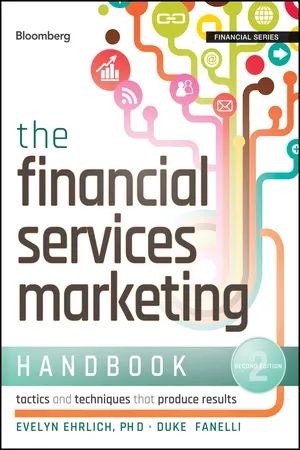
The Financial Services Marketing Handbook
Tactics and Techniques That Produce Results
- English
- ePUB (mobile friendly)
- Available on iOS & Android
The Financial Services Marketing Handbook
Tactics and Techniques That Produce Results
About this book
The roadmap to success for financial professionals using real-world examples, practical how-to's, and a structured approach to marketing strategy and tactics that covers the basics for beginners and inspires new ideas for marketing pros
The Financial Marketing Services Handbook, Second Edition gives sales and marketing practitioners the practical tools and best practices they need both to improve their job performance and their retail and institutional marketing strategies. The FSM Handbook guides marketing and sales professionals working in an industry characterized by cut-throat competition, client mistrust, transformative technologies, and ever-changing regulation, to understand the practical steps they must take to turn these threats into opportunities.
Providing invaluable information on how to target, win, and retain profitable customers, the book presents an overview of the basic marketing functions—segmentation, positioning, brand building, situational analyses, and tactical planning—as they relate specifically to the financial services industry. With up-to-date case studies, showing what has worked and, more tellingly, what hasn't, the book demonstrates how to effectively utilize the marketer's toolbox—from advertising and public relations to social media and mobile marketing.
- Discusses how social media (Twitter, Facebook, blogs, review sites) impact branding and sales
- Packed with new information on landing pages, email success factors, and smartphone apps
- Demonstrates how behavioral economics affect marketing strategy
- Case studies and charts are fully revised and updated
The financial industry is under intense pressure to improve profits, retain high-value clients, and maintain brand equity without straining budgets. The first edition has become an industry-standard reference book and The Financial Services Marketing Handbook, Second Edition gives sales and marketing professionals even more of the information they need to stretch value from each marketing dollar.
Frequently asked questions
- Essential is ideal for learners and professionals who enjoy exploring a wide range of subjects. Access the Essential Library with 800,000+ trusted titles and best-sellers across business, personal growth, and the humanities. Includes unlimited reading time and Standard Read Aloud voice.
- Complete: Perfect for advanced learners and researchers needing full, unrestricted access. Unlock 1.4M+ books across hundreds of subjects, including academic and specialized titles. The Complete Plan also includes advanced features like Premium Read Aloud and Research Assistant.
Please note we cannot support devices running on iOS 13 and Android 7 or earlier. Learn more about using the app.
Information
- Brand building. This is the main reason most companies use brand or “image” advertising (that is, advertising not specifically designed to sell a particular product). Keep in mind that most financial services are bought irregularly. Buyers pay little attention to advertising for products or services that they are not looking to buy. Therefore, the task of financial advertising is to generate a sufficient level of awareness over time to be “top of mind” when the buyer is ready, say, to take out a mortgage, finance a new business, establish an IRA, or engage a new investment banker.
- Familiarity. Advertising gives potential buyers the comfort that they are making the right decision. It is easier for someone to buy from a company that is well known than to take a chance on an unknown quantity. This familiarity also “softens the beaches” for the sales force.
- Customer retention. Advertising reinforces satisfaction among those who have already purchased from a company. In a proprietary study conducted by a leading brokerage firm, advertising was found to have little measurable impact on acquisition of new customers but had a significant effect on client retention.
- Reaching third-party influencers. Institutional advertising is often aimed at senior management rather than at those who actually buy a particular product, with the aim of getting a “trickle-down” referral from the top. Similarly, financial advisers are more comfortable recommending products they feel are well-known to the public.
- Maintaining market share. Companies may be forced into “defensive advertising” in order to keep up with their competitors’ ad expenditures and avoid losing market share.
- Improving employee morale. Advertising can have a positive effect on staff motivation and make recruitment easier.
- Identify the functions the agency will perform, such as account service, research, and media buying and the specific types of assignments, such as new product introductions, positioning or repositioning, brand building.
- Determine whether the assignment will be local, regional, national, or global.
- Will the agency be joining a roster of other agencies, or will there be an exclusive arrangement?
- With which departments and outside ve...
Table of contents
- Cover
- Contents
- Title
- Copyright
- Preface
- Acknowledgments
- Introduction: The Unique Challenges of Marketing Financial Services
- Section One: Strategic Market Planning
- Section Two: Marketing Tactics
- Conclusion
- Appendix: Applying Marketing Principles to Sales Practice
- About the Authors
- Index